The just-redesigned Subaru WRX does not have a 2.0 liter turbocharged four cylinder engine – making it different from others in its class – like the VW Golf GTI and the Hyundai Velosyer N – that do. It also comes standard with a high-performance all-wheel-drive system, as t always has. This is a feature neither of these two front-wheel-drive rivals offer.
It also comes standard with a manual transmission, too – a fun-to-drive feature that another rival – the Mazda3 Turbo – doesn’t offer, either.
All of which makes the WRX has always been.
That being something special.
The WRX is the street-going version of Subaru’s successful World Rally Cup race cars. It is a modern example of what is still called a “stock” car – though the race cars on today’s Nextel Cup circuit have almost nothing in common with the “stock” (i.e., factory production) cars they’re made to sort-of resemble.,
It once meant that the car on the showroom floor – a ’69 Dodge Charger, for instance – was the car upon which the race car was based. Which meant that, once upon a time, you could buy – and drive – the same basic car that the racers were driving.
The WRC cars are based on the “stock” WRX production cars; they share common underthings – and engines – as opposed to common names.
As for example the current Nextel Cup “Camry” – which is about as “stock” a car as Bruce Jenner is a “woman.”
The race car has a V8 engine no stock Camry every offered, driving the rear wheels. The Camry sold at Toyota stores – while a great car – is nothing like the race car, except insofar as the shared name and a vague visual resemblance. 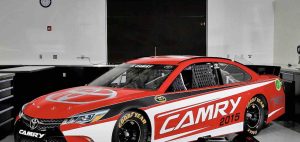
The WRX, on the other hand, is the car on which the race cars are based.
Prices start at $29,605 for the base trim – which comes with most of the essential equipment you’d need to go racing – including the high-performance turbocharged “boxer” engine, six speed manual transmission and Subaru’s race-winning, torque-vectoring AWD system, specially calibrated to maximize handling tenacity via modulation of power delivery in both the straights and the curves.
Just add a rollbar.
Premium and Limited trims ($32,105 and $36,495 respectively) add amenities such as dual-zone climate control, heated seats and a larger (and dual screen) 11.6 inch LCD touchscreen. They are also eligible for options such as a premium 504 watt, 11 speaker Harmon Kardon audio system.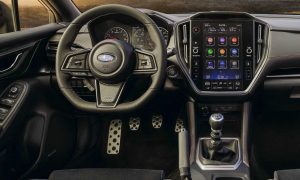
If you’d like a WRX that’s closer to WRC-spec, there’s the top-of-the-line GT – which adds an adaptive suspension, Recaro sport buckets and additional (more aggressive) drive mode settings for the standard Subaru Performance (CVT automatic) transmission that’s optional in other trims.
It stickers for $42,395.
What’s New for 2022
The WRX gets its first major makeover since the 2012 model year.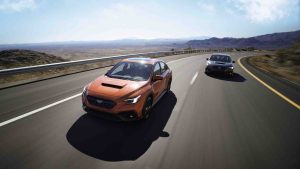
The visual differences are subtle but significant. They include hunkier fenders and several aerodynamic tweaks to increase high-speed stability.
Functionally, they are major – including a new 2.4 liter turbocharged engine and (for those who prefer an automatic) a new CVT that Subaru says upshifts 30 percent faster and downshifts 50 percent faster. This box also comes with a separate oil cooler – for the obvious reasons.
The new WRX is also slightly wider and longer, with a wider track. Its suspension has also been changed up. It features more travel than previously (a boon in Rally racing) and a new “dual pinion” electrically assisted power steering system. The front fenders are made of lightweight aluminum now rather than steel, although the new car’s curb weight (3,297 lbs.) is about the same as the old car’s (3,294 lbs.)
Race car kinship – and experience.
Standard manual transmission and AWD.
Most “driver assistance” systems (including EyeSight) are delete-optioned if you don’t buy the automatic.
What’s Not So Good
Sedan-only bodystyle limits everyday practicality due to small (12.5 cubic foot) trunk.
Highest-performance GT trim comes only with the CVT automatic – and all the “driver assistance” systems, including EyeSight.
WRX STi isn’t available . . . for now.
The new WRX has a larger – 2.4 liter – boxer (i.e., horizontally opposed cylinders) engine in lieu of the previous 2.0 liter boxer engine.
The only other new car that still has a boxer engine is a Porsche, which is lot pricier than a Subaru.
Boxer engines are lower (and lighter) than upright engines and their weight is spread out more evenly on either side of the vehicle’s centerline – as opposed to being in line with it and taller. This improves handling and balance, which is why Porsche uses the layout.
But it’s not necessary to buy a Porsche to get it.
The new 2.4 liter engine is only negligibly more powerful – 271 horsepower and 258 ft.-lbs. of torque vs. the outgoing 2.0’s 268 horsepower and the same 258 ft.-lbs. of torque – and the fuel economy it delivers is slightly worse: 19 city, 26 highway vs. 20 city, 27 highway, previously (with the standard six speed manual transmission).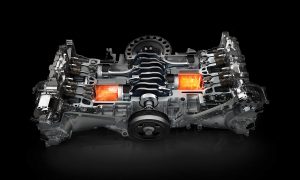
It’s also not any quicker.
Both the new car and the old car take about 5.3 seconds to get to 60.
But the new engine may be better, being bigger. Or rather, longer lived – because it is bigger.
Little engine that are heavily boosted are under a great deal of pressure. Specifically, their internals – such as bearing surfaces. When these are smaller, it is harder on them. Larger pistons also have more area to absorb the pounding they’re subjected to. In a high-performance car especially, a larger – physically stronger – engine will probably last longer than a smaller one subjected to repeated stress.
Subaru says the new 2.4 liter engine – which is equipped with an electronically (rather than mechanically) controlled wastegate – is more responsive and that its torque curve is broader, peaking at 2,000 RPM and maintaining peak through 5,200 RPM – both of which are true (more on the latter follows below). But it may be more important to keep the WRX on the road – rather than in the shop.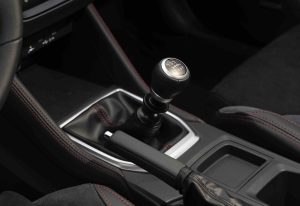
So as to keep buyers coming back to the showroom.
Another element that may contribute to that is the boxer four is only lightly boosted. Just 12 psi, max. Many new vehicles with turbocharged engines are running close to 20 psi – which is a lot of boost.
A new optional automatic is also part of the newness. It is still a continuously variable (CVT) automatic, as before – but Subaru says it “shifts” (in air-fingers quotes, because CVT automatics do not shift, because they aren’t geared; instead, they transition through variable ranges, with electronics mimicking up and downshifts) much more quickly. Subaru says “shifting” up from “second to third” is 30 percent faster and “downshifts” from “third to second” are 50 percent quicker. The Subaru Performance Transmission (SPT) also emulates rev-matching downshifts during braking.
It is standard equipment in the also-new GT trim, which comes with adaptive dampers, Recaro sport buckets and a higher-performance wheel/tire package (light-weight, grey-anodized 18 inch rims wearing 40 series “summer” tires).
Also standard with the GT – and the CVT – is a bevy of “driver assistance technology,” including something styled Evasive Steering Assist, plus Lane Keep Assist, Forward Collision Mitigation (the car brakes when it thinks you’ve failed to notice the need to brake) plus adaptive cruise control.
The good news – if you feel no need for such “assistance” – is that most of the above is deleted if you don’t buy the CVT (or the GT trim).
As before, every WRX comes standard with Subaru’s “symmetrical” AWD system, so named because it splits the power transfer down the Soobie’s centerline and from wheel to wheel, not just front-to-back.
Finally – importantly – the new WRX still has a pull-up emergency brake rather than a push-button electric parking brake. People who follow drifting/rally racing know why this is important.
The WRX has always been a very everyday-drivable performance car. Its boxer engine has never been a “peaky” engine that required a lot of revving before the car got going. And its AWD system makes it formidable on both wet and snow-slicked roads, which usually impose their own harsh discipline on performance cars.
It’s the same again, just more so.
The bigger engine is easier-going – requiring even less revving to get the car going. See that bit earlier above about the more generous torque curve. It pulls with more authority with less apparent effort, so even though the new model isn’t appreciably quicker than the outgoing model, it is stronger feeling in the stop-and-go. This will also probably further serve to increase the lifespan of this Soobie, as less revving usually means less wearing and tearing.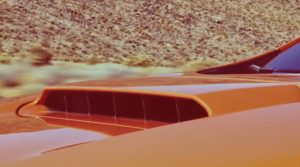
The sound is as good as before.
A boxer engine produces a distinctive – and pleasing – sound. Not just to the performance-attuned ear, either. People know (and never forget) the sound of an old Beetle – which was also powered by a boxer engine.
The Soobie’s boxer is quieter – the sound being muted by the water that cools it. But it does not sound like anything else, except perhaps a 911 (also now water-cooled).
Rowdy is perhaps the right word. Mechanical is another. There is nothing uncivilized about it. Just a suggestion that it can be, if need be. And that is just the right sound for a car like this.
The ride – still firm – isn’t as hard as it was, before. This is no doubt due to the new underlying “global” (rather than Impreza) platform. The revised suspension has more travel, which probably accounts for the increased give – without increasing roll. Subaru says the rear swaybar’s mounting arrangement (directly to the unibody rather than the subframe) plus a lowered center of gravity and a wider track (by 1.2 inches) are responsible for that. All of this improves what was already very good – in the sense that the WRX has always been a performance car that’s also an easy-to-live-with everyday car, too.
Subaru is wanting to get people to appreciate the virtues of the new CVT automatic – standard in the GT, optional in other WRXs – by arranging the kit such that if you want the adaptive dampers, the Recaro seats and the unique-to-this trim 18 inch matte grey anodized 18 inch wheels and 40-series “summer” tires – you have to buy the GT, which is the only WRX that offers these performance upgrades. But that means you have to buy the CVT.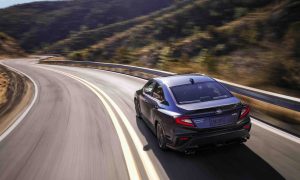
It is not a bad transmission. By the numbers, it is a very good one.
It “shifts” fast – without the harsh transitions (being a CVT) and it’s almost always exactly in the right range for whatever the driving situation is. It is probably true that the GT – with the CVT – is the best racer, in terms of delivering the quickest (and most consistent) acceleration and lap times.
But numbers aren’t always everything, unless you actually are racing. Lots of people who buy cars like the WRX prefer to shift for themselves because it is part of the fun – even if it means not always winning the race.
Because, after all, this isn’t a race.
As before, the WRX is a compact-sized sedan. This means it has a small trunk (just 12.5 cubic feet) relative to the cargo areas that hatchback sedans offer. Which Subaru used to offer but for some reason decided to stop offering. It’s a practicality deficit relative to “hot hatches” such as VW’s GTI, which have more than twice (34.5 cubic feet) the cargo-carrying capacity and the Hyundai Veloster N, which has nearly four times (44.5 cubic feet) the capacity.
But, those hatches do not offer AWD – and the Veloster only has three doors.
While the Soobie’s trunk is tight, its back seats aren’t. With 36.5 inches of legroom and a decent 36.7 inches of headroom, the WRX can comfortably accommodate most adults up to 6 ft tall back there.
The appearance of the new WRX is hard to distinguish from that of the old one – and this is probably good for the same reason that it’s a good idea Coke never changed the shape of its bottle. Once you have something people like, leave it alone – else they might not like it.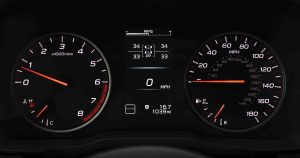
But there are differences – you just have to look for them. They include contrast-color chip guards around the lip of each fenderwell, a larger (and lower) grill, rear fender bulges and more of a scoop on the hood than the previous duct. The interior has been massaged as well, with the most obvious being the 11.6 in center touchscreen that’s standard in the Premium and up trims.
If you’re not into that, you can skip it – by sticking with the base trim.
It’s nice that Subaru leave that “option” available – and doesn’t charge a cent extra for it.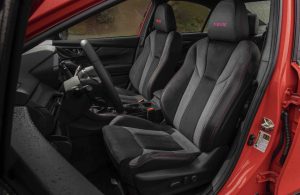
The Rest
While you can’t get the adaptive dampers – or the Recaro seats from the factory – without also getting (and paying top dollar) for the CVT-equipped GT, you can get a factory-installed short-throw shifter for $427 extra – as well as a factory installed STI performance exhaust system for $1,200 extra with any WRX.
You could also get everything except the adaptive dampers over the counter – the Recaros, the matte-grey rims with the 40 series “summer” tires, etc. – and install (or have the dealer) install them on your manual-equipped WRX.
Which might be the best WRX of all.
Well, until the new WRX STi shows up.
The Bottom Line
If you ever wanted to drive a “stock” car . . .
Got a question about cars, Libertarian politics – or anything else? Click on the “ask Eric” link and send ’em in! Or email me at [email protected] if the @!** “ask Eric” button doesn’t work!
If you like what you’ve found here please consider supporting EPautos.
We depend on you to keep the wheels turning!
Our donate button is here.
If you prefer not to use PayPal, our mailing address is:
EPautos
721 Hummingbird Lane SE
Copper Hill, VA 24079
PS: Get an EPautos magnet or sticker or coaster in return for a $20 or more one-time donation or a $10 or more monthly recurring donation. (Please be sure to tell us you want a magnet or sticker or coaster – and also, provide an address, so we know where to mail the thing!)
My eBook about car buying (new and used) is also available for your favorite price – free! Click here. If that fails, email me at [email protected] and I will send you a copy directly!




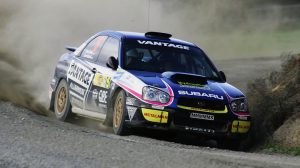
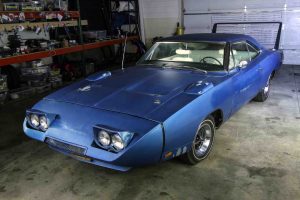
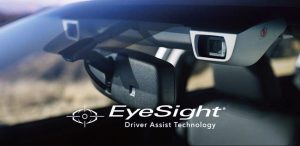
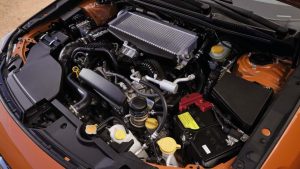



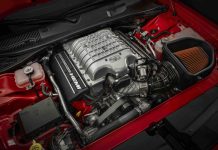






As delivered, my 2017 WRX was impossible to drive smoothly, due to throttle hang and horribly non-linear response to accelerator pedal position. $600 worth of software from Cobb Tuning fixed those shortcomings and turned it into a sweetheart to drive. There’s really no excuse for how poorly the folks at Subaru set this car up.
Hi ft,
The new model is much better sorted – including clutch take-up, which is less abrupt than the previous gen (in my experience).
Eric,
Don’t hold your breath for a new ICE STi – according to Subaru:
“If we designed [a new STI] now, it would have a very limited shelf life…The regulations are changing so quickly that it kind of wouldn’t make any sense.”
-Subaru Director of Corporate Communications Dominick Infante
Hi Mike,
I have heard this, too. Tragic. But truth. It is extremely tough to get any new high-performance car to market without massive expense – at which point, it becomes an exotic. And at that point, few can afford it. So why build what you can’t sell enough of to make it worth it?
GR86 engine failure….subaru engine
https://www.motortrend.com/news/toyota-gr86-engine-failure-warranty-drifting-pics/?fbclid=IwAR2lIFphfC3MMjYgtCd1GTylEiIclb9aAZUb89vW0iasScMX1KG10KjwFjg
I loved my 2002 WRX. Lots of pickup, goes in the rain and snow, and cheap, too.
Only trouble is, there wasn’t much in the way of cargo and passenger space, and I had to use premium gasoline.
I bought a 2003 and later a 2012 Outback thanks to my experiences with my WRX. I’m probably one of only a dozen socially straight edge Libertarians who drives one!
I still have my semi-retired, 2006 WRX (hatch back). It has 235,000 miles on it, and replaced the original clutch at 219,00 miles. It handled very well during the long, cold, dark Winters, between the blizzack tires, all-wheel drive, and the standard transmission. I plan on keeping it as a back-up, as God only knows how my new (automatic trans) car will be, or how long it will last. Albeit, Eric here had a good review for it.
Incorrect Mark, the body on frame had nothing to do with the changeover. Frame cars are notoriously less rigid and strong than a unitized construction. Just the twisting alone causes a massive loss of steering performance under any conditions. A unitized construction car with an added cage is much better in performance overall. Notice that all of the high end brands which can outperform race cars of roughly a decade earlier are all unitized construction.
The body on frame was the skateboard of its day, not unlike the BS they are trying to pull now with an electric base and just change the body. It was a mundane, unsophisticated engineering of a drive platform, only worse in most cases as the American mentality of the solid rear axle prevailed. Look at most frames and one will see severe narrowing at the tunnel section. This is horrible in terms of rigidity and even safety. This setup merely allowed crummy bodies to be placed on a rolling chassis making design easy and easy to change and share up and down a bunch of lines. It is also much cheaper to produce the entire car and requires a lot less sophisticated manufacturing skill. Very few frame cars were ever strong, and showed themselves to crush in all collisions much more than even same year unitized offerings.
The reason for standardizing the race car with the tubular structure was to make racing very low risk for the drivers and permit higher speeds safely. A truly stock car is going to have hard safety limits. It was never designed to crash at racing speeds. The sport lost its tolerance for death and injury of drivers. Funny how the safety cult worked its way into there too. The professional drivers and their sponsors demanded this and other things which made the sport seem more contrived, similar across car brands and that wonderful description: “fake”. In all fairness, now it is much more about driver skill than the car, much like an Olympic event where the equipment is standardized in many regards allowing only specific individual modifications and tuning.
Do not view the old stuff with bias towards it being the better. In most cases it was not.
I am a certified frame repair tech and fixed both. Frame cars are very easily bent and crushed.
You raise a good point: Chrysler vehicles started using unibody construction in 1960. The Super Stock Dodges and Plymouths of the early 60s and later cars like the Charger, Challenger, Road Runner, and Cuda handled the power of 413 and 426 Max Wedge, 440 Magnum/Six Pack, and the 426 Hemi well. They won lots of races, if I recall.
The Golf R is more like the STI….the Subaru STI is more of a boy racer image, the Golf more subdued.
2022 Golf R
6 speed manual
$45,185
315 hp
280 ft lb torque
all wheel drive
0 to 60 mph 4.8 sec.
curb weight 3417 lb
Most Subies are for the granola-chomping, moonbats who cover their back windows with weird political stickers of a left-leaning persuasion. Not this one! I always liked WRXs and I remember I’d never heard of one until the first Gran Turismo video game on PS1, which I played obsessively. That game opened the door to them being sold here and opened the eyes of a lot people of the forbidden fruit of JDM cars, like the Nissan Skyline.
I drove one and liked it greatly, but if you were off the boost, the wonderfully growly flat four was a total dog with scads of turbo lag. I’d assume this 2.4 liter motor doesn’t have that problem?
I had an OG blue/gold 07 “Hawkeye” STi and an 08 STi hatch, along with an 03 Legacy hatch. I feel authorized to say this.
That car is Aztek ugly. Yeah I said it.
True, Local –
Although so is a Mossberg Persuader!
Word
If I remember correctly, which is somewhat in question in my latter years, Subaru AWD has a rear wheel drive bias, as opposed to trans axle AWD cars which have a front wheel drive bias. A good thing.
Hi John
My son had two of them, drifted them, blew them up…lol…
Great car. Glad to see soobie updating it, even a little. Personally, never been a fan of boxer engines, have owned a few, but my perspective is biased coming from in-line 4 racing bikes and the relative magic they produced.
Is the tattoo artist at the dealer or do they give you a voucher?
No, but you get a Vape Pen in the center console free of charge.
Eric,
The cars in NASCAR were more stock at one time, but that was when cars still had body-on-frame construction. Once cars went to unibody construction, stock cars were much less so. Since the unibody cars didn’t have the structural integrity or heft of those whose bodies were mounted on the frames, NASCAR race cars needed to incorporate the tubular space frame. SO! When NASCAR started, the cars were more or less stock. After Uncle mandated CAFE standards, cars went to unibody construction, so they were no longer suitable for racing in stock form.
Hi Mark,
Yup; I think the last “stock” cars in Nextel Cup were circa the late ’80s… but others here who follow it may know better.